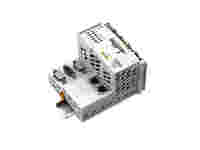Container Virtualization with Docker
Docker makes it easier for you to provide software/applications with container virtualization.
Docker makes it easier for you to provide software/applications with container virtualization.
Docker container technology speeds up software development, testing and deployment, since its handling is based on the behavior of apps. WAGO PFC200 series controllers now make it possible to exploit these advantages on an embedded platform.
In order to be able to react cost-efficiently to ever shorter product cycles in production, production must be networked and become more flexible and agile. Software is required to support factories in meeting new production requirements. However, the preparations for development, testing, delivery and distribution are anything but easy, especially on embedded platforms: Installing and configuring the programs is often laborious, which takes time and slows the digital transformation in companies.
The Docker virtualization technology, based on Linux®, can make software deployment significantly easier, since it packages applications in a portable form. Therefore, in the future, WAGO will offer its PFC200 Series Controllers in Docker-ready form. It will then be possible to use modern software and numerous applications provided by developers around the world on the PFC200, such as the graphical programming tool Node-RED, which can be used to implement application cases in the area of the Internet of Things with a simple modular principle. Previously, embedded operating systems had to be modified for Node-RED – Docker allows it to be used on the PFC200 within a few minutes.
Docker is significantly more lightweight than the standard virtualization, for example from the Windows® environment, since applications can be executed in containers. Containers start faster and require less overhead, and thus fewer hardware resources, than virtual machines, since they don’t need to launch their own operating system and instead run in the host operating system context. Nonetheless, the containers can be isolated from each other and from the host system during execution. This allows multiple applications to be used on one device without affecting each other. It also makes porting entire applications significantly easier. Special Linux® functions such as namespaces and cgroups make this possible.
They are launched from a container image – a simple file that is easy to transfer from one system to another. This makes it easy to use applications, databases and Web applications, as well as to remove them without a trace after use – like mobile apps, which can be loaded and then deleted in very little time. Any number of containers can be launched from a Docker image. The configuration is already set up in the image, and variable parts such as the network configuration are created automatically upon startup.
Docker can provide software and applications quickly, which helps to reduce development and commissioning time. After the firmware extension, the PFC200 is expected to be Docker-ready in February of 2019.
Related to the Topic
Engineer, control and visualize your projects even more easily and conveniently with the PFC200 Controller thanks to e!COCKPIT (CODESYS V3) and Linux®.
